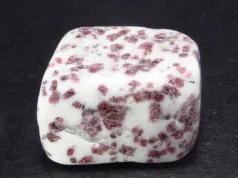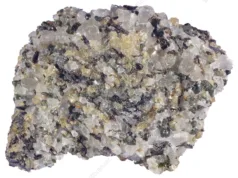Indigo Gabbro, also known as Mystic Merlinite, is a crystal that belongs to the igneous rock family. It is a unique and visually striking stone that is primarily composed of several minerals, including feldspar, chlorite, serpentine, muscovite, and magnetite. The combination of these minerals gives Indigo Gabbro its distinctive appearance, with dark grey to black background coloration and contrasting lighter-colored patches or orbs.
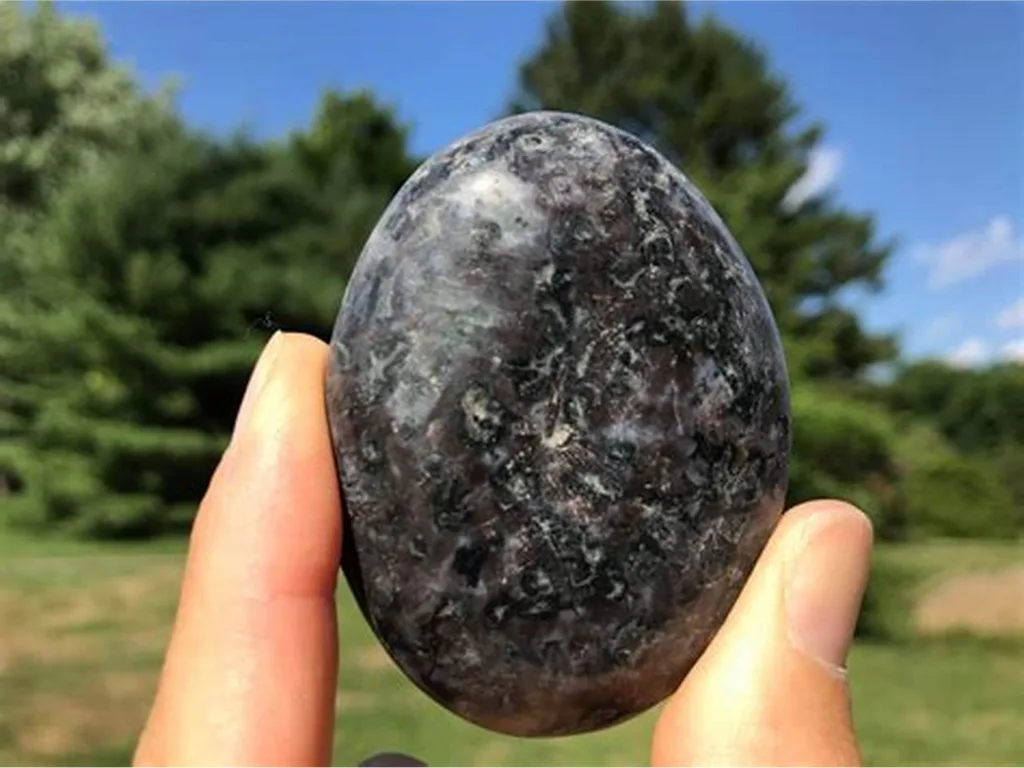
Appearance: Indigo Gabbro is characterized by its deep, almost black background color, often speckled or marked with contrasting patches of white, green, or light grey. These lighter areas can form distinctive patterns, giving the stone an otherworldly appearance.
Metaphysical Properties (not scientific): Mystic Merlinite is believed by some to possess powerful metaphysical properties. It is associated with spiritual transformation, psychic development, and enhancing intuition. The stone is often used in meditation and energy work to access higher realms of consciousness.
Other Names: Indigo Gabbro is commonly known as Mystic Merlinite due to its enchanting and mystical appearance. The name “Merlinite” is inspired by the legendary wizard Merlin from Arthurian lore, adding a touch of magic and mysticism to the stone’s identity.
Uses: In addition to its metaphysical properties, Indigo Gabbro is often used in jewelry and lapidary work. Its unique and captivating appearance makes it a popular choice for those seeking distinctive and meaningful gemstones.
Geological Origin: Indigo Gabbro is primarily found in Madagascar, but it can also be sourced from other locations. It is formed through the slow cooling of molten rock, resulting in a fine-grained texture.
As with many crystals and gemstones, the beliefs and associations with Indigo Gabbro vary among individuals and practitioners. Whether appreciated for its aesthetic qualities or utilized for its perceived metaphysical properties, Mystic Merlinite remains a fascinating and captivating stone in the world of crystals and minerals.
Physical Characteristics

The physical characteristics of Indigo Gabbro, or Mystic Merlinite, encompass a range of properties that contribute to its unique appearance and composition. Here are some key physical characteristics of Indigo Gabbro:
- Color:
- The dominant color of Indigo Gabbro is deep black or dark grey, providing a stark background for other contrasting features. Lighter-colored patches or orbs, often in shades of white, green, or light grey, create a distinctive and visually appealing contrast.
- Texture:
- Indigo Gabbro typically exhibits a fine-grained texture, resulting from its slow cooling process. The individual mineral components are not easily discernible to the naked eye, contributing to the overall smooth and polished appearance of the stone.
- Luster:
- The stone may have a variable luster due to the presence of minerals like muscovite, which can impart a shiny or reflective quality to certain areas of the stone.
- Hardness:
- Indigo Gabbro falls within the range of hardness typical for many igneous rocks. On the Mohs scale of mineral hardness, which ranges from 1 (softest) to 10 (hardest), it is likely to be around 6 or 7. This makes it suitable for use in jewelry and other ornamental purposes.
- Density:
- The density of Indigo Gabbro is influenced by its mineral composition. It tends to have a moderate to high density, which is common for igneous rocks formed from molten material.
- Formation:
- Indigo Gabbro is an igneous rock that forms through the slow cooling and solidification of molten rock (magma). This process occurs beneath the Earth’s surface, allowing the minerals within the magma to crystallize and form the distinctive patterns and textures observed in the stone.
- Magnetic Properties:
- The presence of magnetite in Indigo Gabbro imparts magnetic properties to the stone. While not strongly magnetic, some specimens may exhibit slight attraction to magnets.
- Transparency:
- Indigo Gabbro is generally opaque, meaning that light does not pass through it. The opaque nature of the stone contributes to its deep and mysterious appearance.
These physical characteristics collectively make Indigo Gabbro a visually captivating and aesthetically interesting material. The combination of dark background coloration with contrasting patches and the subtle interplay of minerals contributes to the stone’s appeal for both decorative and metaphysical purposes.
Origin and Formation
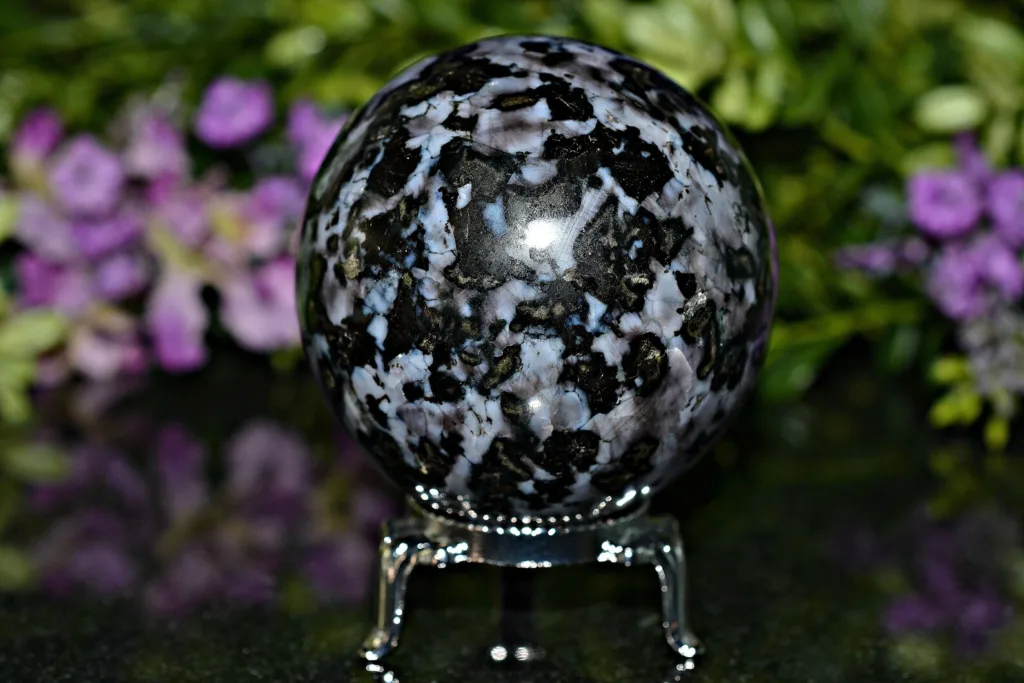
Indigo Gabbro, or Mystic Merlinite, is an igneous rock that forms through the slow cooling and solidification of molten rock, also known as magma. The specific process of its formation is tied to the Earth’s geologic history and involves the following steps:
- Magmatic Intrusion: Indigo Gabbro begins its journey as molten magma beneath the Earth’s surface. This magma intrudes into existing rock formations, creating a mass of hot, fluid rock.
- Slow Cooling: As the magma cools slowly over an extended period, minerals within it begin to crystallize. The slow cooling allows for the formation of fine-grained textures, and the individual minerals have time to arrange themselves into distinct patterns.
- Mineral Composition: Indigo Gabbro is composed of various minerals, including feldspar, chlorite, serpentine, muscovite, and magnetite. The interplay of these minerals gives the rock its characteristic appearance, with dark background color and contrasting patches.
Mining Locations:
Indigo Gabbro is primarily found in specific geological locations, with Madagascar being a notable source. The island of Madagascar is renowned for its rich deposits of various gemstones and minerals, and it is a significant producer of Indigo Gabbro specimens. Other locations where similar rocks may be found include parts of the United States, such as Alaska and California.
Geological Significance:
- Igneous Rock Classification: Indigo Gabbro falls within the category of igneous rocks. Igneous rocks are classified based on their mineral composition, texture, and the cooling process that led to their formation. The slow cooling of magma beneath the Earth’s surface contributes to the fine-grained texture and distinctive patterns observed in Indigo Gabbro.
- Magnetic Properties: The presence of magnetite in Indigo Gabbro gives the rock magnetic properties. While not highly magnetic, this characteristic can be interesting from a geological and mineralogical perspective.
- Geological Time Scale: The formation of igneous rocks like Indigo Gabbro is part of the ongoing geological processes that shape the Earth’s crust. The slow cooling and solidification of magma occur over geological time scales, contributing to the formation of diverse rock types.
- Gem and Mineral Exploration: Indigo Gabbro is valued not only for its geological significance but also for its aesthetic appeal. Gem and mineral enthusiasts, as well as lapidaries, may explore geological formations in search of specimens for collection, lapidary work, or jewelry making.
Understanding the geological background of Indigo Gabbro provides insights into the Earth’s dynamic processes and the conditions that lead to the formation of unique and visually striking rocks. The rock’s distinctive appearance and metaphysical properties also contribute to its popularity among those interested in crystals and gemstones.
Mineral Composition

Indigo Gabbro, or Mystic Merlinite, is composed of a variety of minerals. The specific mineral composition can vary, but the primary minerals present in Indigo Gabbro typically include:
- Feldspar: Contributes to the lighter-colored patches or lines in the stone.
- Chlorite: Imparts a greenish hue to the rock.
- Serpentine: Adds texture and may contribute to a greenish color.
- Muscovite: Occurs in shiny, reflective layers.
- Magnetite: Imparts magnetic properties to the stone.
The interplay of these minerals gives Indigo Gabbro its unique appearance, with a dark background color and contrasting patches or orbs.
Trace Elements:
In addition to the primary minerals, Indigo Gabbro may contain trace elements that contribute to its overall composition. These trace elements can vary and may include elements such as titanium, aluminum, iron, and others. The presence of trace elements can influence the color, hardness, and other physical properties of the rock.
Chemical Composition:
The chemical composition of Indigo Gabbro reflects the abundance of the minerals mentioned above. While the exact chemical composition can vary depending on the specific geological location and individual specimens, the general composition includes:
- Silica (SiO2): Feldspar and quartz are common silicate minerals present in many igneous rocks.
- Aluminum Oxide (Al2O3): Found in minerals like feldspar.
- Iron Oxide (Fe2O3): Magnetite is a significant contributor to the iron content.
It’s important to note that the exact chemical composition may vary, and detailed analysis of a specific sample would provide more accurate information.
Understanding the mineral and chemical composition of Indigo Gabbro is essential for both geological and metaphysical perspectives. The combination of minerals and trace elements contributes to the stone’s physical characteristics, while the energetic properties associated with these minerals are often considered in metaphysical practices.
Uses and Applications
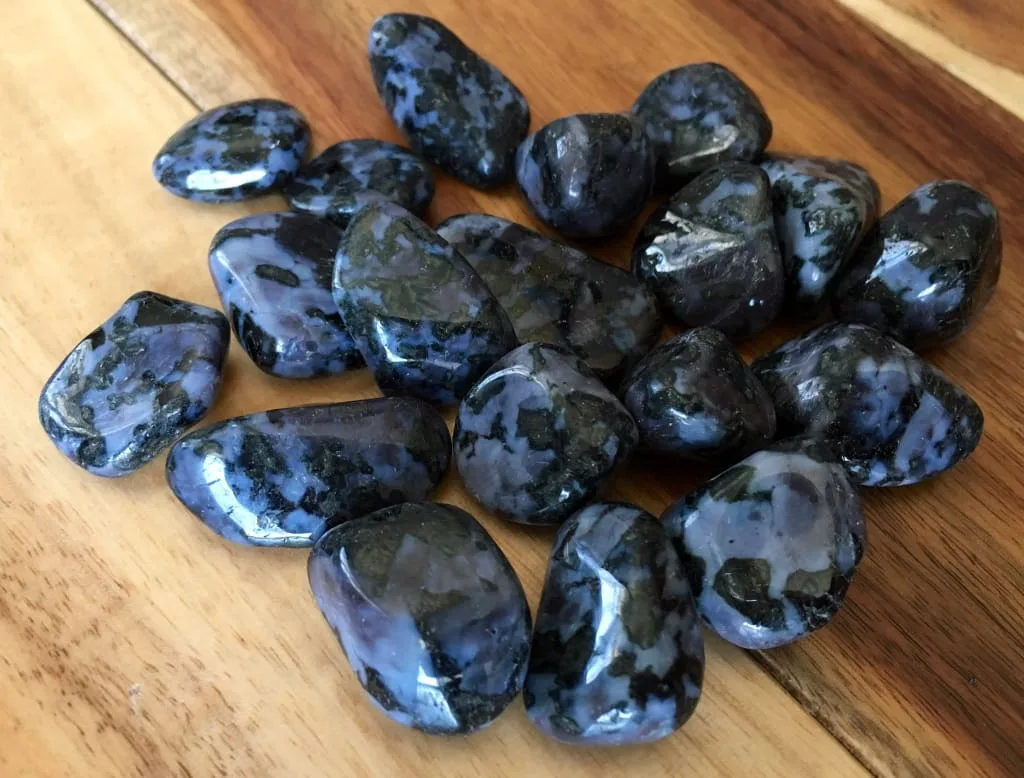
Indigo Gabbro, or Mystic Merlinite, is valued for its aesthetic appeal and metaphysical properties. Its unique appearance and believed energetic attributes make it suitable for various uses and applications. Here are some common ways in which Indigo Gabbro is utilized:
- Jewelry:
- Indigo Gabbro is often used in jewelry making. Its dark background color and contrasting patches or orbs make for visually striking pieces. The stone can be cut into cabochons, beads, or incorporated into various jewelry designs, such as rings, pendants, earrings, and bracelets.
- Meditation and Spiritual Practices:
- Many individuals use Indigo Gabbro in meditation and spiritual practices. The stone is believed to enhance intuition, psychic abilities, and spiritual insight. Practitioners may hold or place the stone during meditation to connect with higher consciousness and promote spiritual growth.
- Energy Work and Healing:
- In metaphysical traditions, Indigo Gabbro is thought to have healing properties. It is associated with balancing energies, releasing negativity, and promoting emotional well-being. Some use the stone in energy work, such as Reiki or crystal healing, to address specific areas of the body or energy centers.
- Home Decor:
- Beyond personal adornment, Indigo Gabbro is sometimes used in home decor. Tumbled stones, spheres, or larger specimens can be displayed in homes or offices for their aesthetic appeal. The unique patterns and colors of Indigo Gabbro can complement various interior design styles.
- Collectibles:
- Gem and mineral enthusiasts often collect specimens of Indigo Gabbro for their unique beauty and geological significance. Collectors may seek out well-formed crystals or unique patterns within the stone.
- Gifts and Talismans:
- Indigo Gabbro is sometimes given as a gift due to its believed metaphysical properties. It is also used as a talisman or amulet by individuals who attribute protective or spiritually enhancing qualities to the stone.
- Artistic Creations:
- Artists and craftsmen may incorporate Indigo Gabbro into their creations, such as sculptures, carvings, or mixed-media artwork. The stone’s distinctive appearance can add an element of mystery and beauty to artistic pieces.
It’s important to note that the uses and applications of Indigo Gabbro are often rooted in personal beliefs and metaphysical practices. While some people appreciate it for its aesthetic qualities and use it in jewelry and decor, others are drawn to its perceived energetic and healing properties. As with any crystal or gemstone, individual experiences and beliefs vary, and the stone’s uses may be subjective.
Indigo Gabbro (Mystic Merlinite) Locations
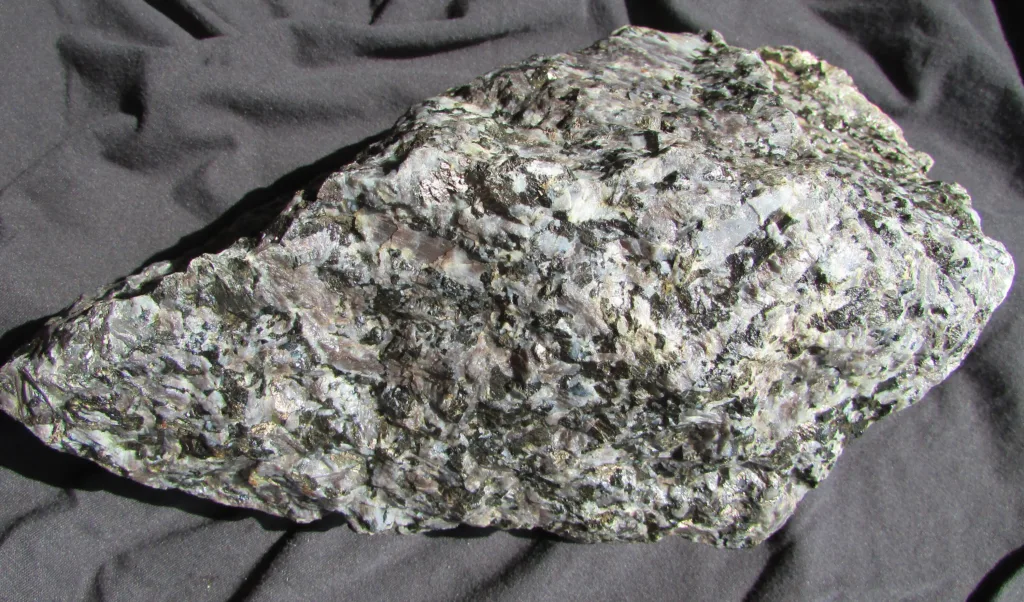
Indigo Gabbro, also known as Mystic Merlinite, is primarily found in specific geological locations. One of the prominent sources of Indigo Gabbro is Madagascar, an island nation in the Indian Ocean. Madagascar is well-known for its rich deposits of various gemstones and minerals, including Indigo Gabbro.
Other possible locations where similar rocks may be found include:
- United States:
- Some sources of Indigo Gabbro are found in the United States, particularly in Alaska and California. These regions may have deposits of rocks with similar mineral compositions.
- Other Localities:
- While Madagascar is a major source, there may be other localities worldwide where variations of Gabbro with similar visual characteristics are found. However, it’s crucial to note that not all Gabbro deposits exhibit the unique combination of minerals and patterns that define Mystic Merlinite.
The availability of Indigo Gabbro can vary, and collectors, lapidaries, and enthusiasts may explore different geological formations in search of specimens. Madagascar remains a significant and well-known source for high-quality Indigo Gabbro specimens.
When seeking Indigo Gabbro or Mystic Merlinite, it’s advisable to purchase from reputable sources that provide information about the stone’s origin and ensure ethical and sustainable practices. Gem and mineral shows, rock and mineral shops, and online vendors specializing in crystals are common places where individuals may find specimens of Indigo Gabbro for sale.


























